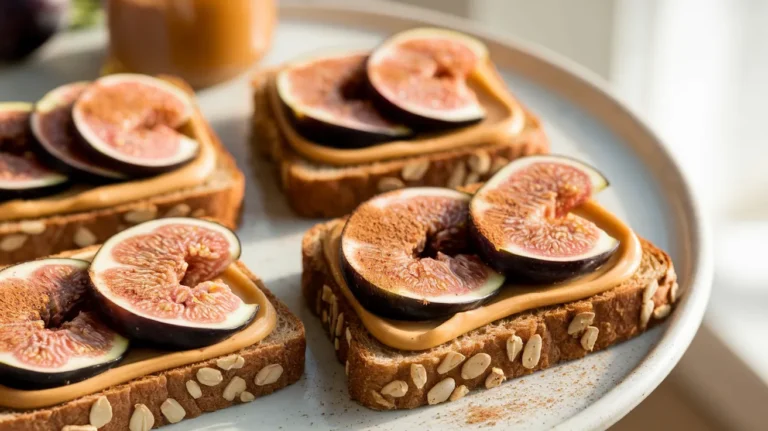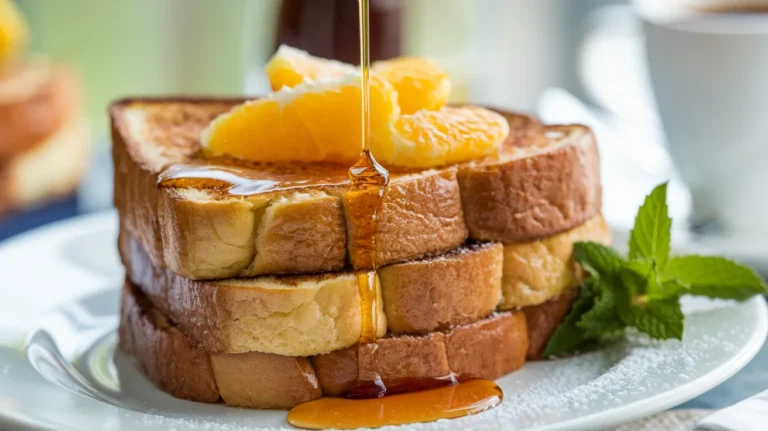Key Takeaways:
- Ready in just 20 minutes – perfect for busy mornings
- Protein-packed breakfast that keeps you full until lunch
- Customizable recipe with easy ingredient swaps
- Family-friendly – scaled for 4 people
Why You Need This Scrambled Egg Toast With Cream Cheese Recipe
Ever stared at your fridge in the morning, hungry but bored with the same old breakfast options? We’ve all been there.
This scrambled egg toast with cream cheese recipe solves that problem in just 20 minutes. It’s the perfect upgrade from basic egg toast and delivers restaurant-quality results at home.
The secret? Cream cheese folded into the eggs creates a rich, velvety texture that takes ordinary scrambled eggs to a whole new level. When spread over crispy toast, it makes a filling breakfast that will keep your family satisfied all morning.
This scrambled egg toast with cream cheese combines protein, carbs, and healthy fats for a balanced meal that’s both simple and satisfying. If you’ve tried our cottage cheese toast with egg, you’ll love this creamy variation!
Nutrition Facts (Per Serving)
| Nutrient | Amount |
|---|---|
| Calories | 315 |
| Protein | 18g |
| Carbohydrates | 22g |
| Fat | 17g |
| Fiber | 3g |
| Sodium | 520mg |
What You’ll Need for Scrambled Egg Toast With Cream Cheese
Ingredients (Serves 4)
| Ingredient | Amount |
|---|---|
| Large eggs | 8 |
| Cream cheese | 4 oz (½ cup) |
| Butter | 2 tablespoons |
| Milk | ¼ cup |
| Salt | ½ teaspoon |
| Black pepper | ¼ teaspoon |
| Chives (chopped) | 2 tablespoons |
| Bread slices | 8 slices |
| Optional: hot sauce | To taste |
Kitchen Equipment
| Tool | Purpose |
|---|---|
| Non-stick skillet (10-inch) | For cooking eggs |
| Whisk | For beating eggs |
| Mixing bowl | For egg mixture |
| Toaster | For toasting bread |
| Rubber spatula | For folding eggs |
| Measuring cups and spoons | For accurate measurements |
| Cutting board | For chopping chives |
| Sharp knife | For cutting cream cheese |
Dietary Notes
- Gluten-free option: Use gluten-free bread instead of regular bread
- Vegetarian: This recipe is vegetarian as written
- Lower fat option: Use reduced-fat cream cheese and egg whites for some whole eggs
Ingredient Substitutions
- Cream cheese: Substitute with ricotta, mascarpone, or Greek yogurt
- Chives: Use green onions, dill, or parsley
- Milk: Almond milk or half-and-half work well
- Bread: Any type works – sourdough, whole grain, or try our easy sweet potato toast for a grain-free option
Step-by-Step Instructions for Scrambled Egg Toast With Cream Cheese
Prep Time: 5 minutes
Cook Time: 15 minutes
Total Time: 20 minutes
Serving Size: 4 people (2 toasts each)
Preparation Phase (5 minutes)
- Set up your workspace
- Clear your counter of any clutter
- Place all ingredients on the counter
- Position your cutting board and knife in a comfortable spot
- TIP: Working in an organized space makes cooking much easier!
- Prepare the cream cheese
- Take cream cheese out of refrigerator 5-10 minutes before cooking
- Open the package and place 4 oz (half of a standard 8 oz block) on your cutting board
- Using a sharp knife, cut the cream cheese into small ½-inch cubes
- BEGINNER TIP: If cream cheese sticks to your knife, dip the knife in warm water between cuts
- Set the cubed cream cheese aside on a small plate
- Prepare the chives
- Rinse 2-3 chive stalks under cold water
- Pat them dry with a paper towel
- Place them on your cutting board
- Using your knife, cut them into tiny pieces (about ⅛-inch)
- Measure 2 tablespoons of chopped chives
- BEGINNER TIP: You can use kitchen scissors instead of a knife if that’s easier
- Mix the egg base
- Place a medium mixing bowl on the counter
- Crack one egg at a time into the bowl
- BEGINNER TIP: Crack eggs on a flat surface (not the bowl edge) to prevent shell fragments
- If shell pieces fall in, use a larger piece of the eggshell to scoop them out
- Continue until all 8 eggs are in the bowl
- Add ¼ cup milk to the eggs
- Add ½ teaspoon salt and ¼ teaspoon pepper
- BEGINNER TIP: Measure salt and pepper with measuring spoons, not just a pinch
- Whisk the egg mixture
- Hold the whisk between your thumb and forefinger
- Whisk the egg mixture using a circular motion until the whites and yolks are fully combined
- Stop when the mixture looks uniform in color (yellow) with no streaks of white
- WARNING: Don’t whisk too vigorously or too long – about 30 seconds is perfect
- Set the whisked eggs aside
Cooking Phase (10-12 minutes)
- Prepare your skillet
- Place your non-stick skillet on the stove
- Turn the heat to medium-low
- BEGINNER TIP: On most stoves, this is about level 3-4 out of 10
- Let the pan heat up for 1 minute
- Melt the butter
- Add 2 tablespoons of butter to the skillet
- Tilt the pan gently to spread the butter as it melts
- Wait until the butter is completely melted and just starts to bubble slightly
- WARNING: Don’t let the butter brown or smoke – if it does, clean the pan and start over
- Start cooking the eggs
- Pour the egg mixture into the skillet with melted butter
- Let it sit undisturbed for 30 seconds
- BEGINNER TIP: The edges will start to look slightly set (less liquid) – this is normal
- Begin folding the eggs
- Hold your rubber spatula at a slight angle
- Gently push eggs from the edge toward the center of the pan
- Continue around the entire circumference of the pan
- BEGINNER TIP: You’re not stirring! You’re folding by lifting cooked portions and letting liquid egg flow underneath
- This entire step should take about 1-2 minutes
- Add the cream cheese
- Once eggs are about 50% set (still wet on top but forming large soft curds)
- Sprinkle the cream cheese cubes evenly over the eggs
- VISUAL CUE: The eggs should look thickened but still be quite wet
- BEGINNER TIP: If eggs are cooking too fast, remove pan from heat for 30 seconds
- Continue folding gently
- Using your spatula, fold the eggs over the cream cheese
- Use slow, deliberate movements – no rapid stirring
- Tilt the pan slightly if needed to redistribute any liquid egg
- BEGINNER TIP: Count to 5 between each fold to avoid overworking the eggs
- Monitor the cooking process
- Watch as the eggs gradually set but stay soft and moist
- Continue the gentle folding motion
- VISUAL CUE: The eggs should look soft, pillowy, and slightly glossy
- This step takes approximately 2-3 minutes
- Check for doneness
- Eggs are ready when they look set but still appear slightly wet
- If you tilt the pan, there should be very little or no liquid egg running
- CRITICAL POINT: Remove from heat while eggs still look a bit too moist
- BEGINNER TIP: The eggs will continue cooking from residual heat even off the stove
- Finish the eggs
- Remove the pan from heat completely
- Add 1½ tablespoons of the chopped chives (save the rest for garnish)
- Gently fold chives into the eggs with just 2-3 strokes
- BEGINNER TIP: Use a taste test – eggs should be warm, creamy, and have no raw taste
Toast and Assembly Phase (5 minutes)
- Make the toast
- Ideally, start toasting when eggs are about halfway done
- Place 8 slices of bread in the toaster (you may need to do this in batches)
- Set to medium level toasting
- BEGINNER TIP: Different toasters work at different speeds, so watch yours carefully
- Toast should be golden brown and firm, not too dark or light
- Looking for toast variations? Check out our collection of French toast varieties for inspiration!
- Keep toast warm (if needed)
- If making toast in batches, place finished toast on a plate
- Cover loosely with a clean kitchen towel to retain heat
- BEGINNER TIP: Don’t use plastic wrap as it will make toast soggy
- Assemble the scrambled egg toast with cream cheese
- Place two pieces of toast on each of four plates
- Using your spatula, divide the egg mixture evenly among the toast pieces
- Spread eggs to cover the bread completely
- BEGINNER TIP: Each toast should get about ¼ cup of the egg mixture
- Final touches
- Sprinkle the remaining chives over the tops of each serving
- Add a few grinds of fresh black pepper if desired
- Add hot sauce on the side (not directly on top) if using
- BEGINNER TIP: Serve immediately while eggs are still warm and toast is crisp

Troubleshooting Common Issues with Scrambled Egg Toast
Problem: Eggs cooking too quickly and becoming rubbery
Solution:
- Turn heat down immediately
- Remove pan from heat source for 30 seconds
- Resume cooking on lower heat
- Next time, start with even lower heat
Problem: Cream cheese not melting into eggs
Solution:
- Make sure cream cheese was cut into very small pieces
- Let cream cheese sit at room temperature longer next time
- If needed, cover pan with lid for 30 seconds to trap heat
Problem: Eggs too runny even after cooking
Solution:
- Continue cooking for 1-2 more minutes
- Ensure you’re using a pan that’s not too large for the amount of eggs
- Check that heat is adequate (medium-low, not too low)
Problem: Toast gets cold before serving
Solution:
- Time your toast to finish just as eggs are done
- Keep toast warm in oven at 200°F
- Use warmed plates for serving
Problem: Eggs sticking to the pan
Solution:
- Use a proper non-stick skillet
- Ensure enough butter was used
- Lower heat as high heat can cause sticking
- Next time, check that pan was properly preheated before adding eggs
Variations & Substitutions for Scrambled Egg Toast With Cream Cheese
Protein Boost
Add 4 oz smoked salmon or ½ cup diced ham to the eggs during the last minute of cooking.
Veggie-Loaded Version
Mix in ½ cup sautéed spinach, mushrooms, or bell peppers just before adding cream cheese.
Spicy Kick
Add ¼ teaspoon red pepper flakes or 2 tablespoons diced jalapeños to egg mixture.
Herb Upgrade
Try different herb combinations: 1 tablespoon fresh dill, 1 teaspoon dried oregano, or 1 tablespoon fresh basil.
Cheese Variations
- Swap cream cheese for 2 oz goat cheese for a tangier flavor
- Add ¼ cup shredded cheddar in addition to cream cheese
- Try feta cheese for a Mediterranean twist
Storage & Reheating Instructions
Storage
- Scrambled eggs: Refrigerate in airtight container for up to 2 days
- Toast: Best made fresh, but can be stored at room temperature in zip-top bag for 1 day
- BEGINNER TIP: Store eggs and toast separately, never as assembled toast
Reheating
- Microwave method:
- Place eggs in microwave-safe dish
- Cover with microwave-safe lid or paper towel
- Heat for 30-second intervals at 50% power
- Stir between each interval
- Stop when eggs reach 165°F or are steaming hot throughout
- Stovetop method:
- Place eggs in non-stick pan
- Add 1 teaspoon butter or oil
- Heat over low heat, stirring gently
- Cook until eggs reach 165°F (about 2-3 minutes)
- Toast reheating:
- Pop in toaster briefly on lowest setting
- Or warm in 300°F oven for 2-3 minutes
WARNING: Never reheat eggs more than once
Safety Tips & Notes
- Eggs should reach internal temperature of 160°F for food safety
- Wash hands with soap for 20 seconds after handling raw eggs
- Keep cream cheese refrigerated until 10 minutes before use
- Discard any eggs or cream cheese left at room temperature for more than 2 hours
- Clean all surfaces that contacted raw eggs with hot, soapy water
- BEGINNER TIP: When in doubt about egg freshness, place in bowl of water – fresh eggs sink, bad eggs float
Final Tips for Success with Scrambled Egg Toast With Cream Cheese
- Quality matters: Use fresh eggs for best flavor
- Low and slow: Patience creates the creamiest eggs
- Timing is everything: Coordinate toast and eggs to finish together
- Make it yours: This recipe is a canvas – add your favorite herbs, spices, or toppings
- For beginners: It’s okay if your first try isn’t perfect – eggs are forgiving
- Texture tip: The perfect scrambled eggs should be soft and creamy, not dry or runny
- For meal prep: Cook eggs and store separately from toast, assembling just before eating
This scrambled egg toast with cream cheese recipe transforms a simple breakfast into something special. The creamy eggs paired with crispy toast create a perfect texture contrast that even picky eaters will love. Try it this weekend!




